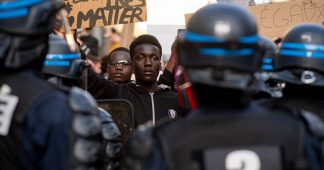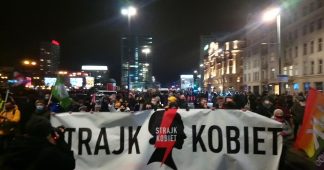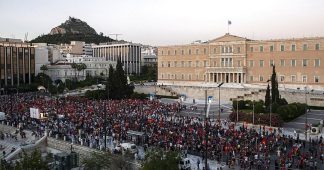By Oscar Grenfell
photo credit: Twitter, @tanya_plibersek
Sweeping claims have been made for national women’s marches held in Australia’s capital cities and major towns on Monday. The protests have been described in the corporate press as “the biggest uprising of women that Australia’s ever seen,” a “turning point” and an “historic moment.”
The superlatives began before the rallies had even been held. An editorial in the Age on Monday morning, promoting the demonstrations, framed them as the latest stage in a struggle against “millennia of discrimination and sexual tyranny.” Before anybody had actually taken to the streets, the Age compared the protests to the massive mobilisations against the Vietnam and Iraq wars, which were directed against illegal imperialist interventions that killed hundreds of thousands.
The Australian, the national flagship of Rupert Murdoch’s media empire, has criticised aspects of the current feminist campaign for its own reasons. It nevertheless published a prominent opinion piece from commentator Caroline Overington, headlined “Why all fathers should join the March4Justice.” Leading figures in the Labor Party, the Liberal Party, the Greens and the trade unions joined media pundits in calling for the largest possible attendance at the protests.
Rarely, if ever, have supposedly oppositional rallies been promoted by such a broad cross-section of the establishment.
This is all the more striking given that the pandemic has been used for the past year to ban virtually all public demonstrations. Mass protests against police violence last June faced attempts by governments to declare them illegal through the courts, furious denunciations from Liberal and Labor MPs, police attacks, and a decidedly hostile reception from the official media.
The near-unanimous support for the women’s marches should give pause to workers and young people. To be blunt, it would be a mistake to abandon one’s critical faculties on the basis of confected, dishonest, and in some cases, ludicrous, media hype.
While some people, including students and youth, no doubt participated in the rallies out of the best of intentions, it is necessary to make a political characterisation of the protests, their class character and the program they advanced.
Monday’s rallies were a semi-official mobilisation of affluent and self-absorbed layers of the upper middle-class, based on the reactionary nostrums of feminist identity politics, and advancing an agenda antithetical to the interests of working people, male and female alike.
Their purpose was to bury any discussion of the major social and political issues facing the working class; promote the fraudulent claim that gender relations are the primary, and perhaps sole issue in contemporary society, and legitimise attempts to undermine basic democratic rights.
Far from being a “grassroots uprising,” the protests were the outgrowth of a media campaign over sexual harassment and assault in the corridors of power. It began in mid-February, when Brittany Higgins, a federal Liberal Party staffer, told the media that she had been raped by a colleague inside parliament almost two years earlier.
At the time, Higgins asked the police to discontinue an investigation less than a fortnight after it began, remained an employee of the government and collaborated with it to keep the story out of the press. During her media appearances last month, however, Higgins stated that she felt she had received insufficient support from her superiors. This was immediately presented by much of the press as cast-iron proof of a systemic culture of support for sexual assault within parliament and virtually everywhere else in Australian society.
In this context, it was revealed that a senior cabinet minister in the government had been accused of an historic rape. Attorney-General Christian Porter was rapidly identified as the subject of the allegation. The incident was alleged to have occurred in 1988, when Porter was a 17-year-old boy. The complainant withdrew from a police investigation last June, before she had signed a statement. Shortly after, she took her own life, meaning that the matter can never be tested in a court.
The media campaign has intensified a crisis of the Liberal-National Coalition government. Internecine conflicts within the Coalition are clearly at play, evidenced by extensive leaking to the press. The media frenzy has also dovetailed with frustration from sections of the ruling elite over the failure of the government to proceed as rapidly as demanded with a sweeping overhaul of workplace conditions and industrial relations, aimed at boosting corporate profits at the expense of the working class.
Whatever the precise motives of the current campaign, it is serving a broader function of burying any discussion of an unprecedented social and economic crisis afflicting masses of people. The women’s marches were held a fortnight before the end of the federal government’s Jobkeeper wage subsidy. This is forecast to throw hundreds of thousands, or even millions of people out of work, on top of already high levels of unemployment.
Rates of poverty, homelessness and social distress have skyrocketed over the past year, as the federal government, with the support of Labor and the unions, has responded to the pandemic by providing hundreds of billions of dollars to big business, and virtually nothing for ordinary people. The ruling elite is well aware that this is provoking widespread social opposition and is fearful that working class struggles are on the agenda.
None of this, however, is openly discussed in the corporate press. Nor is the issue of war. The Coalition government, with the full support of Labor, has deepened Australia’s involvement in US plans for a catastrophic conflict with China, aimed at ensuring American hegemony in the Asia-Pacific. Only last week, the government played a central role in calling the first meeting of the “Quad,” a de facto anti-China alliance of the US, India, Japan and Australia. In strategic think-tanks, this is presented as a significant step on the road of military confrontation with Beijing.
Australia is also held up as an international model for the attacks on democratic rights accompanying the war preparations. Sweeping “foreign interference” laws, passed in 2018, are aimed at criminalising anti-war opposition. They have been accompanied by a McCarthyite and racist campaign, demonising Chinese people in Australia as potential spies.
The official line-up that promoted the women’s marches supports this entire reactionary agenda and is keen that it be kept under wraps. That is why Labor, which has marched in virtual lockstep with the government, has latched onto the feminist campaign as a means of differentiating from the Coalition. Of all the potential bases of opposition to the government, Labor, the Greens and sections of the corporate press have chosen the most right-wing.
Labor and Greens MPs were prominent at the protests, along with some current and former Liberal parliamentarians. Feminist activists, millionaire media commentators and representatives of corporate think-tanks and lobbies were among the speakers.
The most striking aspect of the speeches was their immense distance from the issues facing ordinary people. Amid a worsening social crisis, the affluent speakers called for greater female representation in elite institutions. One of the official demands of the protests was for 50 percent of parliamentarians at the state and federal levels to be women by 2030. Many of the speakers raised that this target should also be applied to corporate boardrooms and company managements.
The Australian Broadcasting Corporation reported the remarks of former Liberal MP Julia Banks, who told the Melbourne rally that “having more women in positions of power would help drive real action on the issues that left many Australian women feeling ‘fed up.’” Innumerable references were made to the need to “break the glass ceiling.” No one elaborated on how having more female representatives of big business and the banks would aid working class women, or anyone but themselves.
Another key plank of the current media campaign is to undermine basic civil liberties and long-established legal principles, including due process and the presumption of innocence.
Higgins, who only reissued a police complaint over the 2018 allegation late last month, told the Canberra rally: “I watched as people hid behind throwaway phrases like ‘due process’ and ‘presumption of innocence,’ while failing to acknowledge how the justice system is notoriously stacked against victims of sexual crimes.”
Other speakers insisted that all complaints of sexual violence or harassment by women had to be believed prior to any judicial process. The #MeToo movement was repeatedly held up as the model. Its primary modus operandi has been the publication of untested allegations against prominent figures, especially in the arts, which serve as the basis of shunning the accused and seeking to destroy their career.
Among the demands of the protests was for an independent inquiry into the allegations against Porter. As legal experts have noted, such an inquiry would establish a dangerous precedent. It would involve the testing of criminal accusations outside of a criminal court and to a lower burden of proof. Because Porter could never be convicted based on the criminal standard of guilty beyond reasonable doubt, a different standard would apply—possibly that used in civil cases when judgement is made on the balance of probabilities.
Such an inquiry would empower the government to establish quasi-judicial proceedings against anyone, and to potentially tar them as guilty of a criminal offence without due process. The precedent could be used against political opponents. This would further widen the broad assault on democratic rights overseen by Labor and Coalition governments for the past two decades.
All in all, the line of the protests was right-wing, directed towards the advancement of a small layer of affluent women within the official political and business structures, and against civil liberties established through centuries of political struggle.
The unions and the pseudo-left have done their best to cover this up. In Canberra, Australian Council of Trade Union Secretary Sally McManus and President Michelle O’Neil called for the campaign to tackle the harassment experienced by working class women. McManus and O’Neil, however, preside over a corporatised organisation that has collaborated with governments and the employers to gut the jobs, wages and conditions of workers, men and women alike, including the most vulnerable and exploited.
For their part, pseudo-left groups such as Socialist Alternative and Solidarity have uncritically promoted the rallies as a progressive struggle against the misogyny of the Liberal Party. In doing so, they are lining up behind the corporate media, Labor and the Greens, and again demonstrating that they represent the interests of privileged sections of the upper middle-class.
Workers and young people should reject the current media campaign. The fundamental division in society is class, not gender. The crucial task facing the working class is to begin an independent political struggle based on socialist principles for its own interests, against austerity, social inequality, war and the assault on democratic rights.
Published at www.wsws.org











